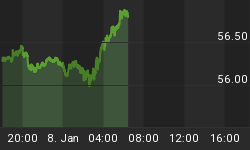A headline from a recent Financial Times newspaper proclaimed "Business leaders laud the Goldilocks Economy." Another article from the Associated Press states, "'Goldilocks economy' looking just right -- Conditions not too hot, not too cold, but will investors notice?" Business Week put on its front cover of its June 6 magazine in bold red letters "Hot Growth" with fireworks in the background (a super bullish cover by BW's conservative standards).
Now fast-forward just one week later and what do we find? The FT reports on its front page the other day, "Weak jobs data fuel fears for economy." In equally big, bold letters Business Week states on the front cover of its June 13 issue, "Sink Hole (How public pension promises are draining state and city budgets)." The same news wires who brought us news of a wonderful "Goldilocks" economy just a few short days ago are now sounding the alarm of a coming possible economic slowdown. And the financial commentary in the pages of the nation's leading business magazines seems to change from bullish to bearish on a week-to-week basis. Can you remember a time when there was so much "volatility" in business/financial reporting in the mainstream press? I certainly can't! What gives?
I'm not assigning blame to the financial reporters who seem to change the tone of their reporting constantly these days. After all, their job is merely to report what they see happening the economy and financial markets, not predict what they think is going to happen. If their reporting of business and economic conditions is subject to frequent change it must be that the economic indicators are giving off too many contradictory and changing signals. And indeed this has been the case this year, especially in the past couple of months.
Economic indicators in general tend not to be as erratic and volatile as the charts measuring various financial markets. But there seems to be a special exception to this rule of late, with many economic leading indicator and composite economic activity charts swinging wildly from one extreme to another. To take one example, check out the chart below courtesy of BullandBearWise.com, a web site devoted to measuring U.S. economic performance (highly recommended).

Pronounced and dramatic increases in volatility often indicate major shifts in market dynamics. In the stock market, a huge increase in volatility can mean, for example, that a bear market is on the way. When the U.S. economy itself witnesses this much volatility in the leading and lagging indicator charts it can only mean one thing, namely, a change in the very nature of the economy is coming about. A paradigm shift of profound proportions is taking place and the resulting "new economy" will be completely unrecognizable compared to the economy of past generations.
The area which has taken the greatest hit - manufacturing - is already a thing of the past and in its place a new service-based economy has emerged. Manufacturing produces value-added and is what gives rise to strong economic growth. Without it, economies eventually falter. As the word "service" implies, a service-based economy places a country in a position of subservience to more powerful nations who have the advantage of a strong manufacturing base.
With manufacturing might follows military might. Strong industrial nations invariably have strong militaries. Conversely, nations who lack strong manufacturing bases have weaker militaries. Therefore the transition to a service-based economy will eventually render America's former military might to a position of subordination (witness the recent closing of some 180 military bases in the U.S.) Much more could be said about this point alone, but that will require a more in-depth analysis.
An article by Martin Wolk titled, "Teens seeking work face fierce competition - Older workers, immigrants taking many entry-level jobs" recently appeared on the MSNBC news wire. Wolk documents that teens are increasingly have a difficult time finding summer employment.
He quotes an expert from the Center for Labor Market Studies at Northeastern University in Boston, one Andrew Sum as stating, "Teens are having a much harder time getting work. Not just in summer but year-round. ... That is partly a new phenomenon. There is something structural going on in the labor market that has made it a lot harder for kids to find work."
I submit that this "new phenomenon" involving "something structural going on in the labor market" is the consequence of the shift toward a global economy with its relaxation of tariff, monopoly, and immigration laws that encourages the build-up of overseas economies at the expense of the United States.
The last time the U.S. experienced a structural shift in its economic infrastructure was in the late 1880s/early 1890s, punctuated by the previous 120-year cycle bottom in 1894. This marked America's transition from an agrarian to primarily an industrial economy. When the next 120-year cycle bottom scheduled for 2014 comes around will America have completed its transition from an industrial to a service-based economy? Tragically, the answer to this question is obvious as America slides headlong into the brave "new economy."
















